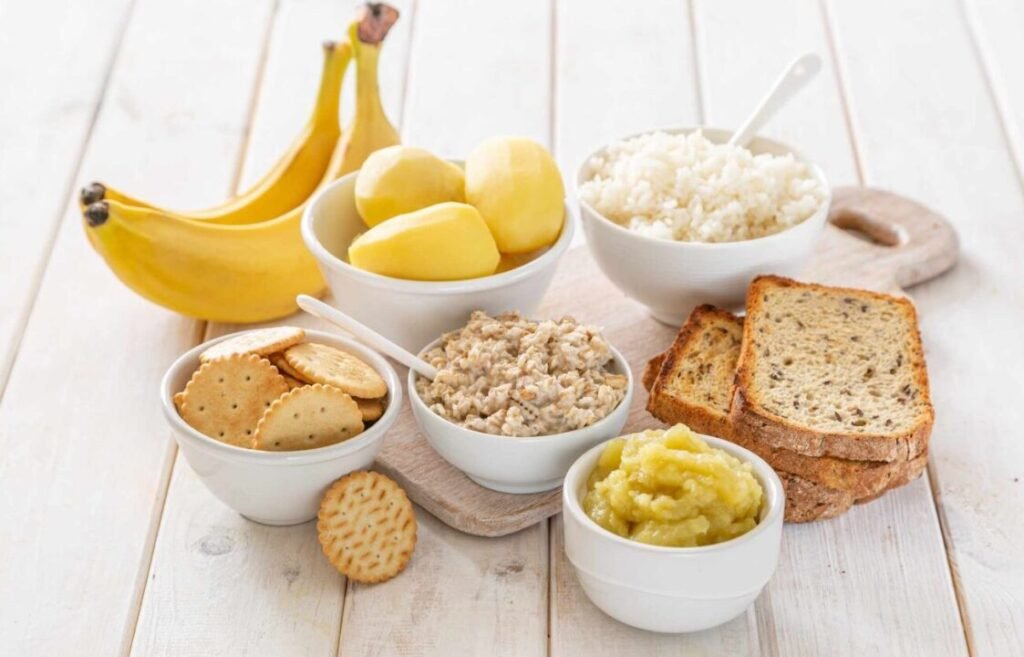The BRAT diet, consisting of bananas, rice, applesauce, and toast, is recommended for temporary relief of mild to moderate gastrointestinal complaints.
Its thorough and detailed food choices are gentle on the digestive system, providing respite from symptoms like diarrhea and nausea. However, the diet lacks nutritional diversity, being deficient in protein, fat, and fiber – a potential risk if followed long-term.
Tips include limiting the diet to short-term usage, maintaining hydration, and pairing foods with probiotics for gut health. Consultation with a healthcare professional is key before initiating this diet.
Analyzing deeper provides a more all-encompassing understanding of its potential benefits and risks.
Understanding the BRAT Diet
To comprehend the BRAT diet, it is critical to understand that this dietary approach primarily focuses on the consumption of bland, low-fiber foods to help alleviate gastrointestinal issues.
The acronym BRAT stands for Bananas, Rice, Applesauce, and Toast.
These foods are chosen for their gentle nature on the digestive system. These foods are not only easily digestible but also known to firm up stools, aiding in the reduction of diarrhea symptoms.

The BRAT diet is generally recommended as a short-term remedy for acute gastroenterological distress, such as during or after bouts of diarrhea, gastroenteritis, or stomach flu.
However, as this diet lacks in comprehensive nutrition, it is not intended for long-term use or as a standalone dietary solution for chronic gastrointestinal problems.
Key Benefits of the BRAT Diet
While the BRAT diet is not designed for long-term use, it does offer several key benefits in mitigating acute gastrointestinal discomfort.
To begin with, the BRAT diet includes foods that are bland and gentle on the stomach, such as bananas, rice, applesauce, and toast. These foods are low in fiber, helping to firm up stools and reduce diarrhea.
Additionally, these foods are high in certain nutrients like potassium and magnesium, which are often depleted during bouts of diarrhea or vomiting.
Thirdly, the BRAT diet can provide temporary relief for nausea, vomiting, or heartburn.
Sample Menu For BRAT Diet
- Day 1
- Breakfast: White toast with a small amount of creamy peanut butter (if tolerated)
- Lunch: Plain white rice with a side of bananas
- Dinner: Applesauce with a slice of dry toast
- Day 2
- Breakfast: Oatmeal with sliced bananas (use water or lactose-free milk if tolerated)
- Lunch: Chicken and rice soup with crackers
- Dinner: Simple baked chicken breast (skinless) with mashed potatoes (if tolerated)
- Day 3
- Breakfast: Cream of wheat with a touch of cinnamon
- Lunch: Grilled cheese sandwich on white bread
- Dinner: Plain pasta with a small amount of steamed vegetables (like carrots or broccoli if tolerated)
Important Considerations
- Hydration: The BRAT diet can be dehydrating. Focus on clear liquids like water, broth, coconut water, or electrolyte beverages throughout the day.
- Duration: The BRAT diet is a temporary solution for easing digestive issues. It lacks essential nutrients. Aim to transition to a more balanced diet within a few days as your symptoms improve.
- Consult a Doctor: If diarrhea persists beyond a few days, worsens, or is accompanied by other serious symptoms, consult a doctor immediately.
Additional Tips
- Small Portions: Eat smaller, more frequent meals instead of large ones.
- Listen to Your Body: Gradually introduce other foods as tolerated. If a specific food upsets your stomach, remove it for the time being.
- Bland is Best: Avoid spicy, greasy, acidic, or high-fiber foods until you’ve fully recovered.
Disclaimer: This is an example menu and shouldn’t replace personalized medical advice. Always consult your doctor before making significant dietary changes, especially during illness.
Potential Risks and Downsides
Despite its benefits, the BRAT diet also poses certain potential risks and downsides that should be carefully considered. One primary concern is the lack of nutritional diversity.
The diet is low in protein, fat, and fiber, which are essential nutrients for body function and recovery.
Additionally, it’s low in vitamins and minerals, potentially leading to deficiencies if followed for an extended period. Another downside is that the diet’s restrictiveness could lead to disordered eating patterns.
Ideal Candidates for the BRAT Diet
Given its unique dietary composition, the BRAT diet is particularly suitable for individuals experiencing mild to moderate digestive issues such as diarrhea or upset stomach.
This diet’s simplicity allows the digestive system to restore its normal functioning without the added strain of processing complex foods.
Patients recovering from surgery or illness who have weakened digestion might also benefit from the BRAT diet. It is not designed for long-term use and should be used as a temporary measure to ease symptoms.
Pediatricians often recommend it for children experiencing gastrointestinal problems.
However, it is not nutritionally complete and is not suitable for individuals with serious chronic digestive issues, pregnant women, or those with dietary restrictions due to health conditions.
It’s always advisable to consult a healthcare professional before starting the BRAT diet.
Handy Tips for Following BRAT Diet
For those opting to follow the BRAT diet, there are several practical tips to keep in mind to guarantee its effectiveness and maintain overall health.
First and foremost, remember that this diet is designed for short-term use only, specifically to manage symptoms of gastrointestinal distress. It’s important to note that it’s crucial to return to a balanced, varied diet as soon as possible as this diet does not provide all necessary nutrients.
Next, ensure to stay hydrated as dehydration is a common risk due to the limited fluid intake.
Lastly, consider pairing the BRAT diet with probiotics to restore gut health and ease digestion. Probiotics can be found in foods like yogurt or taken as supplements.
Always consult with a healthcare professional before starting any new diet plan.
Alternatives to the BRAT Diet
While the BRAT diet offers a vital solution for temporary gastrointestinal relief, there exist several alternative dietary approaches that can also effectively manage digestive issues.
One such method is the ‘FODMAP’ diet, which identifies and eliminates certain carbohydrates that may exacerbate digestive problems.
Another approach is the ‘Gut and Psychology Syndrome’ (GAPS) diet, designed to heal and seal the gut lining, thereby improving digestion.
A third alternative is the ‘Specific Carbohydrate Diet’ (SCD), which restricts the intake of complex carbohydrates to support gut health.

It’s important to consult a healthcare professional before starting any new diet, to make sure it’s appropriately tailored to your individual health needs and nutritional requirements.
At The End
To sum up, the BRAT diet offers a simplistic and easily digestible nutritional route for those experiencing gastrointestinal distress.
However, its limitations in nutritional diversity may pose risks if followed long term. It should be employed judiciously, preferably under professional guidance.
The exploration of alternative diets with similar benefits but greater nutritional variety is also recommended for best health maintenance.
